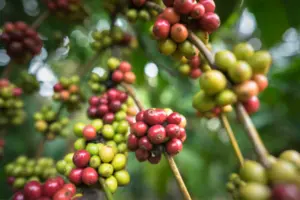Turkish Coffee Vs Espresso; Caffeine, Grind, Taste, Cup
Disclosure: This post contains affiliate links and I may earn a small commission (at no extra cost to you) if you click through and make a purchase. Thanks in advance – I really appreciate it!
The first time I tasted Turkish coffee was on my first trip to Turkey, almost a decade ago. I remember the waiter bringing a glass of water and a bowl of sugar along with the coffee.
Until then I used to believe that espresso and Turkish coffee have a lot of similarities, but boy was I wrong!
Although both brewing techniques originated in Europe and are arguably one of the oldest styles of preparing coffee, they are quite different in so many ways.
So you may ask, how is Turkish coffee different from espresso?
Turkish Coffee vs Espresso
Turkish coffee uses a light-medium roast coffee and an extremely fine grind size, like soft powder or the texture of flour. Espresso, on the other hand, uses a darker roast which is also ground fine but a bit coarser than Turkish grinds, like table salt.
Key Takeaways:
- Turkish coffee is made by boiling coffee grounds in water in a specialized pot, called a cezve.
- Espresso is generally made through a specialized tool such as an espresso machine, an AeroPress, or a Moka pot.
- Turkish coffee uses extremely fine coffee grind, Espresso, on the other hand, uses a fine grind (but coarser than Turkish).
- Turkish coffee generally has more caffeine content than espresso.
- The differences in grind size, brewing method, and brewing time mean that both Turkish coffee and espresso have two distinct flavor and aroma profiles that make it impossible to confuse one for the other.
Turkish coffee and espresso are both quite strong beverages and both are served in a demitasse, but they are different in so many ways.
From the type of beans, grind size, preparation, and preparation time, you will be surprised to learn each brew is unique.
Here’s a table depicting the main differences between Turkish coffee & espresso:
| Turkish Coffee | Espresso | |
|---|---|---|
| Grind Size | Extremely fine, like the texture of the soft powder. | Fine grind but coarser than Turkish coffee. |
| Caffeine | More caffeine per serving because of the larger serving size. | Lesser caffeine per serving because of the low volume of a shot of espresso. |
| Roast | Use any roast you please. | Use any roast you please. |
| Brew time | 5 minutes | 25-30 seconds |
| Taste & Flavor | Bold taste with thick & rich flavor. | Strong taste with thick and creamy flavor from the crema. |
| Serving style | Served in Turkish coffee cups called “fincan”. | Served in espresso cups or “demitasse”. |
Turkish Coffee Vs Espresso: How are they made?
Although there are many similarities between Turkish coffee and espresso, the two brewing styles could not be more different.
They both get their strong flavors because of very different factors.
Turkish coffee is made by boiling coffee grounds in water in a specialized pot, called a cezve. If desired, sugar can be added along with various other spices such as cardamom for extra flavor.
Espresso, on the other hand, gets a strong flavor because highly pressurized hot water is forced through the coffee grinds in an espresso machine.
You can make Turkish coffee with creamy foam on top without any special equipment, but it won’t be possible to make authentic espresso with crema without some kind of equipment.
Later in this article, we will discuss how Turkish coffee and espresso differ in caffeine content, taste, grind, cup size, roast, strength, health effects, and more.
But to learn more about the differences between Turkish coffee vs espresso, it’s important that you should understand how each brewing method works.
How is Turkish coffee made?
The preparation of Turkish coffee is one of the oldest ways to brew coffee. It is made by mixing water with finely ground coffee beans and (often sugar) and bringing the liquid to a frothy foaming stage, just before boiling.
Turkish coffee is made in a small traditional stove pot called ‘cezve’ or ‘ibrik’.
Cezve (pronounced jehz-veh) is a metal pot with a wide bottom and tiny opening on top and a long handle attached to it.
The cezve is traditionally made of brass or copper, though stainless and other suitable materials, such as ceramics, can be used as well.
Turkish coffee is prepared by adding the finely ground coffee to an empty cezve and then adding room-temperature water. The cezve is then typically placed over a gas flame and heated until boiling.
Upon heating and boiling, the coffee forms a layer of foam at the top of the cezve. At this point, the coffee is allowed to cool slightly before boiling again to form more foam.
Once the coffee has been prepared, almost the entire contents of the cezve are emptied unfiltered into a small cup called a demitasse.
As Turkish coffee isn’t filtered through cloth or paper, the coffee after preparation is allowed to sit for some time so that most of the coffee grounds fall to the bottom forming a layer at the base of the cup.
It can be served unsweetened. However, it is often made with moderate amounts of sugar. It is also a common practice to add cardamon to Turkish coffee.
Depending upon the amount of sugar you add to your coffee, your Turkish coffee can have different names. Below is how Turks call this:
- “Sade” – sugar-less Turkish coffee.
- “Az sekerli” – a little bit of sugar, about 1/2 teaspoon.
- “Orta sekerli” – medium amount of sugar, approximately 1 teaspoon.
- “Cok sekerli” – lots of sugar, probably with 1 1/2 to 2 teaspoons.
- Handmade engraved copper coffee pot with wooden spoon. Made in Turkey. Small. 9 Oz for 3 People for 3 Demitasse Cups of coffee.
- This pots body is completely solid 2mm thick copper. Not lacquered. So it will develop a natural patina outside, as real copper should. Lined with food safe lead-free tin.
Prices pulled from the Amazon Product Advertising API on:
Product prices and availability are accurate as of the date/time indicated and are subject to change. Any price and availability information displayed on [relevant Amazon Site(s), as applicable] at the time of purchase will apply to the purchase of this product.
How is Espresso made?
Espresso is generally made through a specialized tool such as an espresso machine, an AeroPress, or a Moka pot. However, the best shot of espresso can be achieved only from an espresso machine.
To brew espresso, start by warming up the espresso machine and placing your coffee grounds into the portafilter.
Then, tamp the coffee grounds until its surface becomes even and flat.
Now place the portafilter into the espresso machine’s group head, and once correctly placed, start the brewing process.
Note that, to extract espresso, your machine needs to have at least 9 bars of pressure. This pressure makes the brewing process shorter. Normally, the espresso drips for about 20-30 seconds only.
The Key Differences Between Turkish Coffee & Espresso
Now that you know how each type of coffee is prepared, it will be much easier to understand the differences between Turkish coffee vs espresso.
You’ll be surprised to know that the difference in preparation is not the only primary difference between the two.
In this section, we will discuss how Turkish coffee differs from espresso in terms of:
- Grind size
- Caffeine
- Roast
- Brewing time
- Taste & flavor
- Health
- Cups
Let’s begin with the most important difference between the two brewing techniques.
Turkish Coffee Vs Espresso: Grind Size
As a general rule, for Turkish coffee, the coffee beans are ground extremely fine, like the texture of the soft powder. Espresso, on the other hand, uses a fine grind (but coarser than Turkish). The espresso grinds are generally similar to the texture of table salt.
The coffee grind size used is the biggest difference in Turkish coffee and espresso preparation.
The Turkish grind is actually one level finer than espresso grind and normally requires a hand grinder or a burr grinder to achieve such fine particle size.
Turkish coffee calls for an extremely fine grind size because, during the preparation, coffee grinds are imbibed in boiling water for some time which allows for the dissolution of soluble solids, making this brew bold & very flavorful.
On the other hand, espresso’s fine grind size is best suited for rapid pressure brewing where hot water is forced through the coffee grinds for 25-30 seconds to make a shot of espresso.
This pressurized hot water brewing is also responsible for the creation of crema on top of the espresso.
Turkish Coffee Vs Espresso: Caffeine
Turkish coffee generally has more caffeine content than espresso.
Espresso typically uses darker roasts and we know that dark roast coffee beans tend to lose caffeine during the longer roasting process.
Turkish coffee, on the other hand, uses light-medium roast coffee and while brewing the coffee grinds remain in contact with water for longer, so more caffeine is extracted.
You’ll be surprised to know that a cup of drip coffee contains more caffeine than a cup of Turkish coffee or a shot of espresso.
This is because a cup of drip coffee is at least 6 oz. in volume as compared to 1.5 to 2 oz. serving of Turkish coffee or espresso.
So the amount of caffeine that you consume from a particular coffee beverage is directly proportional to the volume of that beverage you’re consuming.
All things considered, you’re likely to get more caffeine from Turkish coffee as compared to a shot of espresso. Also, Turkish coffee usually has a thicker texture and tastes more intense.
Turkish Coffee Vs Espresso: Roast
The type of roast has nothing to do with the strength of either Turkish coffee or espresso.
Most coffee lovers prefer darker roasts for both Turkish coffee as well as espresso, but you can use any roast you please.
Try experimenting with different roasts before finalizing your preferred choice for either type of coffee.
However, it’s worth mentioning that dark roast works best for espresso coffee. In fact, most espresso blends you can find are of dark roast.
Similarly, a large proportion of Turkish coffee consumers prefer their coffee to be light roast as light roast coffee beans are perfect at maintaining the aroma and flavor authenticity.
So, the kind of roast that you use is completely up to your taste preference as the type of roast hardly makes any difference to the drink’s strength.
Turkish Coffee Vs Espresso: Brew Time
Despite being a centuries-old brewing method, the preparation of Turkish coffee doesn’t take too long.
You can have a cup of delicious Turkish coffee ready within 5 minutes. Besides, you can prep two or more servings at a time in the same pot.
Moreover, if you’re making Turkish coffee by the manual, then the cezve is supposed to be on the flame for 2 – 2.5 minutes only.
On the other hand, espresso takes even lesser time to brew than Turkish coffee. An experienced barista can get your shot ready in under a minute, as the brewing itself only takes 25 to 30 seconds.
Automatic and super-automatic espresso machines are equally fast. However, they can produce one or two shots at a time.
Automatic espresso machines require little to no supervision and can be programmed to have espresso ready for you when you wake up.
Making Turkish coffee, on the other hand, requires constant supervision or it may boil and overflow making a mess of your stove.
Turkish Coffee Vs Espresso: Taste & Flavor
The differences in grind size, brewing method, and brewing time mean that both Turkish coffee and espresso have two distinct flavor and aroma profiles that make it impossible to confuse one for the other.
The flavor of Turkish coffee is bold, but not in the smoky way that Starbucks coffee is bold. Rather, it’s condensed like espresso with a strong bittersweet flavor.
Turkish coffee is thick and rich. The thickness of coffee comes from using the extra-fine coffee grounds that are present in the cup that gives Turkish coffee their authentic muddy texture.
Moreover, the sugar that is generally added in the cezve during coffee preparation gives Turkish coffee a distinctly sweet, caramelized flavor.
A freshly prepared shot of espresso, on the other hand, is going to be thick and creamy with a dense “crema” sitting on top of the espresso base.
In general, espresso tastes very strong, slightly to quite bitter, and often a bit tart-like lemon. If made properly, it should have a naturally sweet finish.
Espresso is the best way to enjoy coffee in its pure form. The natural flavors and aromas are really brought forth by the high-pressure brew.
Which is healthier?
Both Turkish coffee and espresso provide the same health benefits as any other black coffee does. However, often Turkish coffee is consumed with some sugar that might add extra calories to the beverage.
A typical serving of sweetened Turkish coffee contains around 11.5g of sugar which brings the overall calories to 46kcal per cup.
Drinking Turkish coffee or espresso or any other black coffee is known to provide many health benefits such as lowering the risk of type 2 diabetes, protecting against diseases such as Alzheimer’s & dementia, protecting against heart diseases and certain types of cancers.
Turkish Coffee Vs Espresso: Cup
Turkish coffee cups are wide-bottomed and have a capacity of 2-2.5 oz. and are designed to keep the coffee hot for the time needed for the grounds to settle down. Espresso cups, on the other hand, have a capacity of 2-3 oz. and their smaller size keeps the crema nice and thick and helps retain heat.
Turkish coffee cups (called “fincan”) are a necessity for serving Turkish coffee.
Turkish coffee has a higher temperature than espresso due to its making method and it needs to rest for a few minutes before consumption so that the coffee grinds settle down at the bottom of the cup.
This is why the Turkish coffee serving cup must have all the properties that are needed to keep the beverage hot for a long period of time.
Espresso cups or demitasse cups, on the other hand, should be 2-3 oz. If the cup is too big, the crema spreads out, becomes thin, and disappears quickly.
Additionally, a large cup affects the temperature of the espresso and you run the risk of it becoming cold quickly.
Similarities Between Turkish Coffee & Espresso
They both use fine coffee grind size, although Turkish coffee uses coffee ground finer than espresso grind, almost like soft powder or the texture of flour.
- They both have a strong flavor profile.
- Both originated in Europe.
- When made well, both have a crema or foam (from the coffee itself) on the top.
- Both are served in small cups or demitasse.
- And that’s it, this is where the similarities end.
Frequently Asked Questions
Can you make Turkish coffee with espresso grounds?
Since espresso grinds are typically a bit coarser than Turkish coffee grinds, using them to make Turkish coffee will result in a weak and under-extracted cup of coffee. Moreover, because of the coarser coffee grinds, the coffee will taste muddier and grittier than authentic Turkish coffee.
In the preparation of different types of coffee, the grind size is strictly specific— there is very little room for adjustment.
This is because grind size greatly affects the extraction time and the quality of the yielded brew.
For example, the preparation of authentic espresso calls for fine grind size but using a coarser grind for espresso will result in a weak coffee without crema, even if you use the best possible espresso machine possible.
Can you use Turkish coffee in an Espresso machine?
Turkish coffee is typically ground finer than espresso grinds. Using Turkish coffee in an espresso machine will likely produce a bitter, over-extracted cup of coffee. Moreover, the extra-fine Turkish coffee grounds may end up clogging the espresso machine.
Espresso machines are designed to quickly force extremely hot water through fine coffee grinds to extract a lot of flavor in a short amount of time.
Coarse grinds take time to release their flavor, whereas finer grinds allow you to extract their flavor very quickly.
So if you’ll use extra-fine coffee grounds (Turkish coffee) in an espresso machine, a lot of flavors will be extracted very quickly which will produce a bitter, sour tasting cup of coffee.
Is Turkish coffee stronger than Espresso?
Turkish coffee is unarguably stronger than espresso. Turkish coffee has a stronger coffee flavor and a bold taste and aroma. Moreover, when compared to espresso, Turkish coffee has higher caffeine content. However, large volume espresso-based drinks such as lattes may have more caffeine.
Is Turkish coffee the same as Espresso?
Turkish coffee is not the same as espresso. Turkish coffee is ground twice as fine as espresso and generally uses a light-medium roast as compared to espresso’s dark roast. Espresso machines use a high-pressure brewing technique whereas Turkish coffee is made by boiling coffee grinds in water.
Is Turkish coffee better than Espresso?
Turkish coffee has a stronger coffee flavor and an intense aroma as compared to espresso. Turkish coffee also has a higher caffeine content and a bolder, muddier taste. Espresso, on the other hand, is generally extremely strong and flavorful and has finer consistency and texture than Turkish coffee.

Amit Gupta
Hi, my name is Amit Gupta, and I am the owner and contributor at Cafeish. My obsession with coffee started when I received my first French press as a gift almost ten years ago. Since then, my love of coffee – and the number of coffee gadgets I own – has grown considerably.
Most Popular
ABOUT US
We are a team of coffee affcianados with experience and expertise in making world renowned coffee. In fact, preparing the best coffee ever with a fluffy top reminds us of magic, with secrets of how to achieve each particular effect. Making coffee is not our only hobby, we always keep our ears open as to what’s happening around and what scientists and manufacturers produce for consumers. It’s not an easy task to do – it’s rather time consuming. Hence, Caféish website was launched.
LEGAL DISCLAIMER
Caféish is a participant in the Amazon Services LLC Associates Program, an affiliate advertising program designed to provide a means for sites to earn advertising fees by advertising and linking to Amazon.com. Caféish also participates in affiliate programs with Clickbank and other sites. Caféish is compensated for referring traffic and business to these companies.





